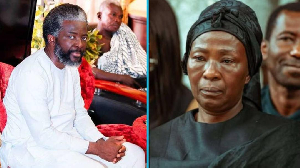The World Bank, at the just-ended 2010 annual meeting in Washington DC, stabbed Ghana in the back. This was demonstrated by horrible pictures that the Bank displayed about the country on its computers installed on the 3rd Floor of the International Monetary Fund (IMF) HQ2 Building located on the 1818 Pennsylvania Street in Washington DC.
The computers, which had a picture of the Finance Minister of Ghana, Dr Kwabena Duffuor as well as the country’s flag, also had pictures portraying the country as a land of abject poverty. Each year, the World Bank and the IMF bring to Washington DC around 10,000 central bankers, ministers of finance, private sector executives, and academics to discuss issues of global concern.
Usually, during the meetings, the Bank displays pictures of member countries on computers to showcase their economic prospects to delegates and investors. This time round, the pictures displayed by the Bretton Woods institutions portrayed Ghana as a country full of hungry and miserable people.
The reputable organization has forgotten that even in Washington DC, the capital city of US, there are people who are still begging on the streets. However, the bank failed to photograph some of these people, let alone display them as the image of the US on its computers to the tens of thousands of delegates who attended the 2010 annual meeting.
Some observers say though the pictures created a bad image for Ghana, they also proved that World Bank’s assistance to the country has not yielded any positive result because it is a piece-meal that comes with stiff conditionalities.
This further explains why some section of the population of Ghana is in that poor state. “The main aim of the World Bank is to bring together the resources of many countries to provide loans for those in need, so that growth and prosperity might take the place of poverty and despair.
These pictures show that the Bank is losing the fight against poverty in Ghana,” a civil society activist, Edward Funnel, remarked. On the other hand, some observers too argued that the bad pictures are a reflection of bad governance on the part of the Government of Ghana which has left the people in that state of abject poverty.
In the past, Africa has been portrayed by the western media as a continent of violence, poverty, starvation and corruption. The pictures displayed by the Bretton Woods institutions about Ghana seem to suggest that it supports the theory that when a dog bites a dog, it is no news but when a man bites a dog then it is news. In other word, bad news sells more than good news.
A Kenyan journalist, Kelly Mbani, asked: “Why couldn’t the country office of the World Bank in Ghana show pictures of interesting and attractive places such as Trassacco Valley, East Legon, the Accra Shopping Mall, Boti Falls, and Kakum National Park?”
Another journalist from Nigeria asked: “Did the Ghanaian delegation led by the Minister of Finance, Dr. Kwabena Duffuor and his Deputy, Fifi Kwetey see those pictures and what were their reactions?”
Mostly, foreign journalists who are sent to Africa are assigned only in times of crisis.
Though some disasters reported about the continent in the international media might be true, the issue has always been with the tone and the exclusion of the positive news happening on the continent.
General News of Monday, 18 October 2010
Source: Daily Guide
World Bank Paints Ghana Black













